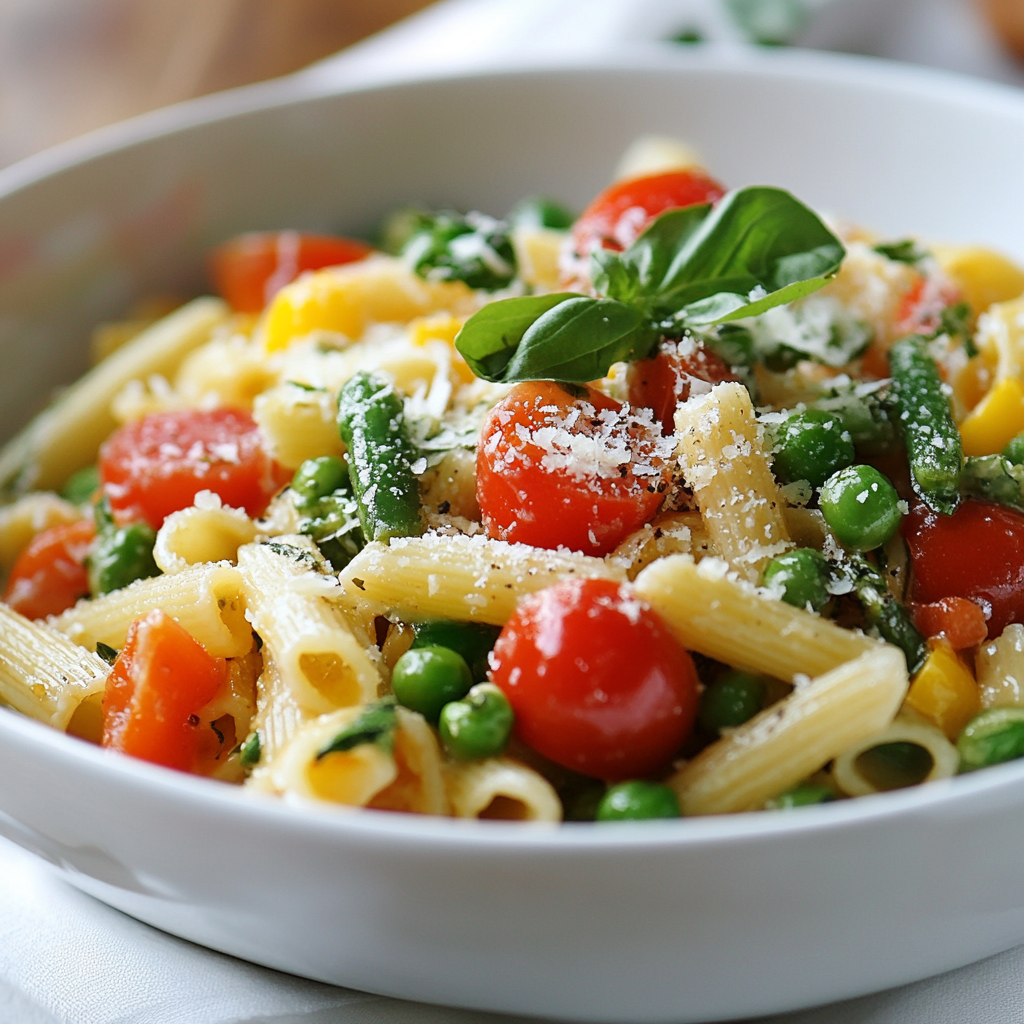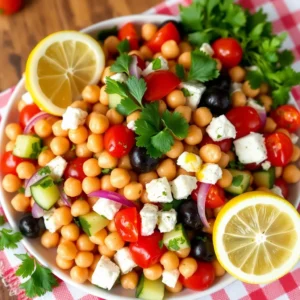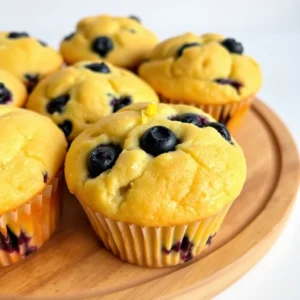There’s something magical about a dinner that comes together quickly, tastes like you spent hours in the kitchen, and secretly packs in all those veggies your family might normally push to the side of their plates. That’s exactly what this Pasta Primavera brings to your table – a vibrant, colorful meal that celebrates fresh ingredients while being completely doable on even your busiest weeknight.
Hi there! Alexandre here from foodytasty.com, and I’m so excited to share one of my absolute favorite springtime recipes with you. As a busy parent myself, I understand the dinner struggle – you want something nutritious, but also something that won’t have you standing over the stove for hours while hungry family members ask “Is dinner ready yet?” every five minutes. This Pasta Primavera is my answer to that eternal question!
Why You’ll Love This Pasta Primavera
First off, let’s talk about flexibility. This Pasta Primavera recipe is less of a strict rulebook and more of a friendly suggestion. Got zucchini but no bell peppers? No problem! Kids won’t touch broccoli but devour peas? Switch it up! The beauty of this dish is that it celebrates whatever fresh vegetables you have on hand or whatever’s looking particularly good at the grocery store this week.
Second, it’s quick. We’re talking 30 minutes from pantry to plate, which makes it perfect for those evenings when you’re juggling homework help, that work email you forgot to send, and trying to locate someone’s missing soccer cleat all at the same time.
And finally, it’s a complete meal in one pot. Protein, veggies, and carbs all hanging out together in perfect harmony. Cleanup is minimal, which means more time for you to actually sit down and enjoy your creation.
The Secret to Perfect Pasta Primavera
The word “primavera” means “spring” in Italian, and this dish truly captures the essence of the season – bright, fresh, and full of life. The secret to making it sing isn’t fancy techniques or hard-to-find ingredients – it’s all about celebrating those vegetables at their peak freshness.
Unlike heavier pasta dishes that rely on rich sauces to carry the flavor, Pasta Primavera lets the natural sweetness and texture of fresh vegetables take center stage. That first bite of tender-crisp broccoli or the burst of a juicy cherry tomato is what makes this dish special.
The second secret? Don’t overcook those veggies! They should maintain some bite – what fancy chefs call “al dente” – which not only preserves their nutrients but gives your dish that restaurant-quality texture that’ll have everyone thinking you’ve been taking secret cooking classes.
Ingredients You’ll Need
For this vibrant Pasta Primavera, gather:
- 12 oz pasta (spaghetti, penne, or your favorite shape)
- 1 tbsp extra virgin olive oil
- 1 small onion, finely chopped
- 1 bell pepper, thinly sliced (mix colors for visual appeal)
- 1 zucchini, sliced into half-moons
- 1 cup cherry tomatoes, halved
- 1/2 cup broccoli florets
- 1/4 cup fresh basil leaves, chopped
- 1/4 cup grated cheese
- 2 garlic cloves, minced
- 1 tbsp freshly squeezed lemon juice
- Salt and pepper, to taste
- Optional: pinch of red chili flakes for heat
- Optional: 1/4 cup pine nuts or slivered almonds for crunch
What I love about this ingredient list is that it’s completely customizable based on seasonal cooking opportunities. Spring vegetables like asparagus and peas work beautifully, while summer gives you eggplant and extra tomatoes. The base recipe stays the same, but the character changes with the seasons!
Let’s Make Pasta Primavera – Step by Step
Step 1: Cook That Pasta Just Right
Bring a large pot of water to a rolling boil – and don’t be shy with the salt! Your pasta water should taste like the sea, as the Italians say. This is your first opportunity to build flavor.
Add your pasta of choice and cook according to package directions until it’s al dente – that perfect point where it’s cooked through but still has a slight firmness when you bite into it. Nobody likes mushy pasta!
Here’s a pro tip that makes all the difference: before draining your pasta, scoop out about 1/2 cup of that starchy pasta water. This liquid gold will help create a silky sauce later on. Drain your pasta and set it aside while you work on those beautiful vegetables.
Step 2: Vegetable Magic Happens Here
In a large skillet or pan, heat that tablespoon of olive oil over medium heat. Add your chopped onion first, giving it a 2-3 minute head start until it becomes translucent and fragrant – this builds your flavor base.
Next, in go the bell peppers for another 2 minutes. I love using a mix of red, yellow, and orange for a stunning color palette that makes this dish as beautiful as it is delicious.
Now for the star moment – add your zucchini, cherry tomatoes, and broccoli florets all at once. This is quick weeknight dinner efficiency at its finest! Sauté everything for about 4-5 minutes, stirring occasionally. You want your vegetables tender but still with a slight crunch. Remember, they’ll continue cooking a bit more once you combine everything.
Step 3: Aromatics Bring It All Together
Time to wake up those flavors! Add the minced garlic to your vegetable medley and cook for just about a minute. Garlic burns quickly and becomes bitter, so keep an eye on it – when you can smell that heavenly aroma wafting up from the pan, you’re good to go.
Now for the brightness – drizzle that fresh lemon juice over everything and season with salt, pepper, and if you’re feeling adventurous, a pinch of those red chili flakes. This acidic note from the lemon is what elevates your Pasta Primavera from good to “can I have the recipe?” territory.
Step 4: The Grand Finale
Add your cooked pasta directly to the skillet with all those gorgeous vegetables. Using tongs or two large spoons, gently toss everything together, adding splashes of that reserved pasta water as needed to create a light sauce that clings to every strand of pasta and vegetable.
Finally, sprinkle in your fresh basil and grated cheese, tossing once more to incorporate all those flavors. The heat from the pasta and vegetables will slightly wilt the basil, releasing its aromatic oils, and melt the cheese into a delicate sauce that brings the whole dish together.
If you’re using those optional pine nuts or almonds, now’s the time to add them for a wonderful textural contrast that makes each bite interesting.
And just like that, dinner is served! Transfer your creation to a large serving dish, add a final sprinkle of cheese and fresh basil on top for that picture-perfect presentation, and bring it to the table while it’s still warm.
Troubleshooting Tips & Tricks for Perfect Pasta Primavera
Even the simplest recipes can sometimes throw us a curveball, but don’t worry – I’ve got your back with some practical solutions to common Pasta Primavera challenges:
Vegetables cooked unevenly? This happens to the best of us! The fix is simple: add your vegetables to the pan in order of density. Start with firmer veggies like carrots or broccoli, then add medium-dense ones like bell peppers, and finish with the quickest-cooking ones like tomatoes or spinach. Or, for an even easier solution, cut denser vegetables into smaller pieces than softer ones.
Pasta stuck together? No need to start over! Just rinse it quickly under warm water to separate the strands, then toss it with a tiny bit of olive oil before adding to your vegetables. Next time, remember to stir your pasta occasionally while it’s cooking and dress it immediately after draining.
Sauce too dry? That’s what that reserved pasta water is for! Add it a tablespoon at a time until you reach the perfect consistency. If you forgot to save some (we’ve all been there), a splash of broth or even plain hot water with a drizzle of olive oil can save the day.
Too bland? This is usually a salt issue. Remember that vegetables need proper seasoning to shine. Don’t be afraid to taste and adjust as you go. A squeeze of fresh lemon at the end can also wake up all the flavors if they seem muted.
Leftovers not as good the next day? Pasta Primavera tends to dry out in the fridge. When reheating, add a small splash of water or broth to the pan, cover, and warm gently. Finish with a drizzle of fresh olive oil and a sprinkle of cheese to bring it back to life!
Making Pasta Primavera Kid-Friendly
As a parent who’s navigated the choppy waters of picky eating, I’ve discovered some sneaky strategies to make vegetable-packed dishes like Pasta Primavera more appealing to the younger crowd:
First, involvement is key. When kids help prepare vegetables – even if it’s just tearing basil leaves or helping to stir – they’re much more likely to eat the final product. My 8-year-old Sophie now asks to be the “official cheese sprinkler” whenever we make this dish!
Second, consider presentation. Sometimes separating components can work wonders for hesitant eaters. Try serving the pasta with small piles of vegetables arranged around it, letting kids choose which ones to mix in. You might be surprised what they’ll try when given a sense of control.
Finally, a little rebranding goes a long way. In our house, this isn’t just Pasta Primavera – it’s “Rainbow Pasta.” Something about hunting for all the colors of the rainbow on their plate makes my kids much more enthusiastic about eating those vegetables!
Seasonal Variations for Year-Round Enjoyment
While Pasta Primavera traditionally celebrates spring vegetables, this versatile dish can be adapted for any season:
Spring: Embrace tender asparagus, sweet peas, and peppery arugula for a true celebration of the season. Fresh herbs like chives and mint add brightness.
Summer: When gardens and farmers’ markets overflow with produce, load up on juicy tomatoes, sweet corn kernels, and tender zucchini. Fresh basil is abundant now and pairs perfectly.
Fall: Create a heartier version with diced butternut squash, Brussels sprouts, and kale. A pinch of nutmeg or sage brings in those cozy autumn flavors.
Winter: Focus on more readily available vegetables like broccoli, cauliflower, and bell peppers. Roasting them first adds deeper flavor that’s perfect for colder months.
A Personal Note From My Kitchen to Yours
I’ll never forget the first time I served this Pasta Primavera to my family after a particularly chaotic Tuesday. The kids had after-school activities, I had back-to-back Zoom meetings, and my husband was stuck in traffic. The dinner window was shrinking by the minute.
Instead of reaching for takeout, I quickly chopped what vegetables we had, boiled some pasta, and threw this dish together in what felt like moments. As we finally all sat down together, frazzled and hungry, something magical happened – everyone went quiet. My youngest, who normally negotiates vegetable consumption like a seasoned diplomat, was happily twirling broccoli-laden pasta. My husband, who’d had a rough day, visibly relaxed.
That’s when I realized the true power of a good Pasta Primavera – it’s not just about getting dinner on the table quickly or sneaking in more vegetables. It’s about creating a moment of colorful, delicious calm in the middle of our busy lives. It’s become our reset button meal, the dish I turn to when we need to pause and connect over something simple and good.
Your Burning Pasta Primavera Questions, Answered!
Q: Can I make Pasta Primavera ahead of time?
A: While this dish is best enjoyed fresh, you can prep components ahead of time to make dinner assembly lightning-fast. Chop all your vegetables and store them in the refrigerator up to 24 hours in advance. You can even cook your pasta, toss it with a tiny bit of olive oil to prevent sticking, and refrigerate it separately. When it’s time for dinner, just sauté the vegetables and combine everything – dinner in 15 minutes flat!
Q: How can I add protein to my Pasta Primavera for a more filling meal?
A: This vegetable pasta dish is incredibly versatile when it comes to adding protein! For a quick weeknight dinner upgrade, try adding grilled chicken strips, sautéed shrimp, or flaked salmon. For vegetarian options, white beans, chickpeas, or cubes of firm tofu work beautifully. Just add your protein of choice when combining the pasta with vegetables and warm through.
Q: Can I use frozen vegetables if fresh aren’t available?
A: Absolutely! While fresh vegetables provide the best texture for Pasta Primavera, frozen vegetables are a fantastic time-saving option, especially during seasons when certain produce isn’t readily available. The trick is not to thaw them first – add them frozen directly to your sauté pan and cook until just heated through. This prevents them from becoming soggy. A mixed bag of frozen vegetables can transform into a delicious meal with this recipe!
Beyond The Basic Recipe: Creative Spins on Pasta Primavera
The beauty of cooking is making recipes your own, and Pasta Primavera is the perfect canvas for creativity. Here are some of my favorite variations that still honor the quick, fresh spirit of the original:
Mediterranean Twist: Add a handful of olives, some crumbled feta instead of the grated cheese, and a sprinkle of oregano. Finish with a drizzle of good olive oil for an instant vacation on a plate.
Asian-Inspired: Skip the cheese and instead toss your pasta and vegetables with a quick sauce made from soy sauce, a touch of honey, ginger, and garlic. Sprinkle with sesame seeds and green onions for a fusion dish that comes together in minutes.
Roasted Vegetable Version: If you have a bit more time, try roasting your vegetables instead of sautéing them. The caramelization brings out natural sweetness and adds incredible depth of flavor to your Pasta Primavera.
The Heart of Seasonal Cooking
At its core, Pasta Primavera isn’t just a recipe – it’s a philosophy about cooking with what’s fresh, vibrant, and available. In our busy lives, it’s easy to get stuck in food ruts, making the same dishes over and over. This simple pasta dish reminds us to look around, see what’s in season, and celebrate it in the most delicious way possible.
When you embrace seasonal cooking, magic happens: your grocery bill often goes down, your meals taste better because ingredients are at their peak, and you naturally vary your diet throughout the year. Pasta Primavera encourages this mindful approach to food while still being completely practical for real-life dinner situations.
A Few Final Tips Before You Cook
Before you head to the kitchen to create your own version of this colorful dish, I want to share a few final thoughts:
Trust your taste buds! Recipes are guidelines, not rigid rules. If you think your Pasta Primavera needs a little more lemon or an extra handful of basil, go for it. Make it yours.
Don’t stress about perfection. Sometimes the vegetables might cook a little more than intended, or the pasta might be slightly softer than al dente. It will still be delicious, I promise!
Make this recipe work for your life. If pre-chopped vegetables from the grocery store save you precious time, use them! If you only have dried herbs instead of fresh, adjust the amounts and carry on.
In the end, the best Pasta Primavera isn’t the one that looks most like a magazine photo – it’s the one that brings a smile to your face when you take that first bite, the one that makes dinner a moment of joy rather than just another task to complete.
So here’s to colorful plates, to quick and satisfying meals, and to the simple pleasure of a really good Pasta Primavera bringing a little brightness to your busy day. I hope this becomes a staple in your recipe collection, just as it has in mine.
From my kitchen to yours, happy cooking!
Looking for More Seasonal Inspiration?
If you enjoyed this Pasta Primavera recipe, you might also love my Mediterranean Chickpea Salad for another fresh, vegetable-packed meal that comes together quickly.
For more pasta goodness with a different flavor profile, try my Creamy Garlic Parmesan Pasta – it’s comforting but still light enough for a weeknight.
Want to learn more about cooking with seasonal produce? Check out this helpful Seasonal Produce Guide from the Seasonal Food Guide for information on what’s at its peak in your area.



